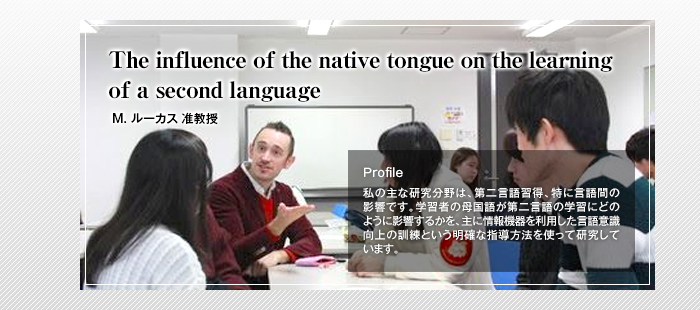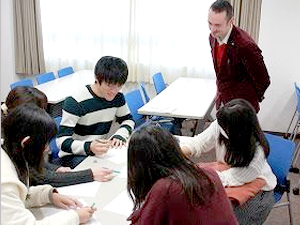- トップ
- 教員が語る専門領域の魅力
- 教員が語る専門領域の魅力 vol.17 M. ルーカス 准教授
M. ルーカス 准教授

What is “cross-linguistic influence”?

Imagine if someone were to ask you what kind of fruit you like. In Japanese, you could reply by saying 「バナナが好きです」. If we then literally translate this into English, it may become “I like banana.” Can you spot the grammatical error? In Japanese, if we talk about something in a generalized sense (such as the kinds of things we like), the concept of whether it can be counted (“countability”) is not particularly important. However, in English, it is very important because it determines which grammatical forms are used. This means, instead, we should say, “I like bananaS.” If we forget to use the plural “-s,” it may be because of the influence of the native tongue. This phenomenon is called “cross-linguistic influence.”
The relevance of cross-linguistic influence to Japanese learners

Since Japanese and English are grammatically very different, cross-linguistic influence can have far-reaching effects. To continue with the previous example, we may accidentally say “I like banana and eat it often” instead of “I like bananaS and eat THEM often.” Similarly, we may forget to use articles (“a” and “the”): “There is A banana on THE table.” These errors are likely to occur because plural forms (including the way they are conceptualized) and articles do not exist in the same way in Japanese. My research has also shown that loanwords (such as “banana”) may be even more difficult to use correctly in English because their form could become “fixed” from Japanese. These factors, among others, may adversely affect grammatical accuracy.
Raising awareness can help to improve accuracy

Having identified some common learning problems, we next need to think about how to solve them. One way is to become more “aware” of how Japanese and English can express the same meanings in different ways through their grammatical forms. Teachers can help their students through “explicit instruction.” This kind of instruction explains what is to be learned and provides opportunities to put it into practice. In this case, such instruction actively points out the differences (and sometimes similarities) between Japanese and English, a technique known as “cross-linguistic awareness-raising.” My research has shown that once learners start to “notice,” or “listen to,” these differences, it is possible to lessen the effects of old habits and improve grammatical accuracy.
学生のみなさんへのメッセージ
Developing awareness during the language-learning process holds within it a powerful metaphor: through first carefully observing what we encounter in life, we can then respond accordingly and use it as a tool to improve ourself. As the saying goes, “learn to listen, listen to learn.”






